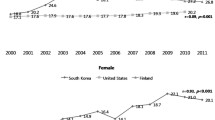Abstract
There are notable differences in suicide methods between countries. The aim of this paper is to analyse and describe suicide methods in children and adolescents aged 10–19 years in different countries/territories worldwide. Suicide data by ICD-10 X codes were obtained from the WHO Mortality Database and population data from the World Bank. In total, 101 countries or territories, have data at least for 5 years in 2000–2009. Cluster analysis by suicide methods was performed for countries/territories with at least 10 suicide cases separately by gender (74 for males and 71 for females) in 2000–2009. The most frequent suicide method was hanging, followed by poisoning by pesticides for females and firearms for males. Cluster analyses of similarities in the country/territory level suicide method patterns by gender identified four clusters for both gender. Hanging and poisoning by pesticides defined the clusters of countries/territories by their suicide patterns in youth for both genders. In addition, a mixed method and a jumping from height cluster were identified for females and two mixed method clusters for males. A number of geographical similarities were observed. Overall, the patterns of suicide methods in children and adolescents reflect lethality, availability and acceptability of suicide means similarly to country specific patterns of all ages. Means restriction has very good potential in preventing youth suicides in different countries. It is also crucial to consider cognitive availability influenced by sensationalised media reporting and/or provision of technical details about specific methods.
Similar content being viewed by others
References
Kolves K, De Leo D (2014) Suicide rates in children aged 10 to 14 years worldwide: changes in the last two decades. Br J Psychiatry 205:283–285
Kolves K, De Leo D (2016) Adolescent suicide rates in 1990–2009: analysis of age group 15 to 19 years worldwide. J Adolesc Health 58:69–77
World Health Organization (2014) Preventing suicide: a global imperative. WHO, Geneva
Ajdacic-Gross V, Weiss MG, Ring M, Hepp U, Bopp M, Gutzwiller F, Rössler W (2008) Methods of suicide: international suicide patterns derived from the WHO mortality database. Bull World Health Organ 86:726–732
Värnik A, Kõlves K, Allik J et al (2009) Gender issues in suicide rates, trends and methods among youths aged 15–24 in 15 European countries. J Affect Disord 113:216–226
Yip PSF, Caine E, Yousuf S, Chang SS, Wu KC, Chen YY (2012) Means restriction for suicide prevention. Lancet 379:2393–2399
Florentine JB, Crane C (2010) Suicide prevention by limiting access to methods: a review of theory and practice. Soc Sci Med 70:1626–1632
Hawton K, Saunders KEA, O’Connor RC (2012) Self-harm and suicide in adolescents. Lancet 379:2373–2382
World Health Organization (2016). WHO mortality database (WHO-MDB). http://www.who.int/healthinfo/statistics/mortality_rawdata/en/. Accessed 15 March 2016
World Bank (2016). Health nutrition and population statistics. http://databank.worldbank.org/data/reports.aspx?source=health-nutrition-and-population-statistics:-population-estimates-and-projections. Accessed 15 March 2016
United Nations (2016). Demographic yearbook (DYB) regular issues 2000–2010. http://unstats.un.org/unsd/demographic/products/dyb/2000_round.htm. Accessed 15 March 2016
Mishara BL (1999) Conceptions of death and suicide in children ages 6–12 and their implications for suicide prevention. Suicide Life Threat Behav 29:105–118
Gunnell D, Eddleston M, Phillips MR, Konradsen F (2007) The global distribution of fatal pesticide self-poisoning: systematic review. BMC Public Health 7:357
Mergl R, Koburger N, Heinrichs K, Székely A, Tóth MD, Coyne J et al (2015) What are reasons for the large gender differences in the lethality of suicidal acts? An epidemiological analysis in four European countries. PLoS One 10(7):e0129062
Dawson AH, Eddleston M, Senarathna L, Mohamed F, Gawarammana I, Bowe SJ, Manuweera G, Buckley NA (2010) Acute human lethal toxicity of agricultural pesticides: a prospective cohort study. PLoS Med 7(10):e1000357
Gosney H, Hawton K (2007) Inquest verdicts: youth suicides lost. Psychiatr 31:203–205
Pritchard C, Hansen L (2015) Examining undetermined and accidental deaths as source of ‘Under-Reported-Suicide’ by age and sex in twenty Western Countries. Community Ment Health J 51:365–376
Palmer BS, Bennewith O, Simkin S, Cooper J, Hawton K, Kapur N, Gunnell D (2015) Factors influencing coroners’ verdicts: an analysis of verdicts given in 12 coroners’ districts to researcher-defined suicides in England in 2005. J Public Health (Oxf) 37:157–165
Crepeau-Hobson F (2010) The psychological autopsy and determination of child suicides: a survey of medical examiners. Arch Suicide Res 14:24–34
Biddle L, Donovan J, Hawton K, Kapur N, Gunnell D (2008) Suicide and the internet. BMJ 336:800–802
Biddle L, Gunnell D, Owen-Smith A, Potokar J, Longson D, Hawton K, Kapur N, Donovan J (2012) Information sources used by the suicidal to inform choice of method. J Affect Disord 136:702–709
Tsai CW, Gunnell D, Chou YH, Kuo CJ, Lee MB, Chen YY (2011) Why do people choose charcoal burning as a method of suicide? An interview based study of survivors in Taiwan. J Affect Disord 131:402–407
Dunlop SM, More E, Romer D (2011) Where do youth learn about suicides on the Internet, and what influence does this have on suicidal ideation? J Child Psychol Psychiatry 52:1073–1080
Acknowledgments
This study is supported by the Australian Research Council Linkage grant “Trends and predictors of suicide in Australian children” (LP0990918).
We would like to acknowledge our partners: the Commission for Children and Young People and Child Guardian (CCYPCG), Queensland Department of Justice, Office of State Coroner (OSC); Queensland Mental Health Commission (QMHC); and, Department of Education, Training and Employment (DETE).
We would also like to acknowledge Damian Shaw-Williams for his thorough linguistic revision of the manuscript.
Author information
Authors and Affiliations
Corresponding author
Ethics declarations
Conflict of interest
None.
Appendix
Appendix
See Table 4.
Rights and permissions
About this article
Cite this article
Kõlves, K., de Leo, D. Suicide methods in children and adolescents. Eur Child Adolesc Psychiatry 26, 155–164 (2017). https://doi.org/10.1007/s00787-016-0865-y
Received:
Accepted:
Published:
Issue Date:
DOI: https://doi.org/10.1007/s00787-016-0865-y




